Ants collected at Big Hammock Natural Area, Tattnall County, Georgia
Joe A. MacGown and JoVonn G. Hill
Big Hammock Natural Area is located along the northeast bank of the Altamaha River in Tattnall County, Georgia. The natural area is a sandhill community that occupies approximately 800 acres and adjoins the Big Hammock Wildlife Management Area (WMA), which encompasses 6,177 acres. The sandhill formation found here was formed by depositions of sand from the Altamaha River. Although the WMA is comprised primarily of bottomland hardwood forest with oxbow lakes and sloughs, the natural area is a sand ridge that includes a variety of habitats such as cypress/gum forest and turkey oak-sand live oak forest. The natural area is host to several rare plants and animals.
Sandhill and otherwise sand-rich habitats in Florida have been documented to have highly diverse ant faunas (Lubertazzi and Tschinkel 2005, Van Fleet 1958). Although some recent work has been done documenting the ant fauna of the Fall Line Sandhills in Georgia (Graham et al. 2004), there has been little study of other sandhill habitats in the state. Graham et al's. research was mostly limited to the Fort Benning area in Chattahoochee County and included a variety of habitat types. The only comprehensive study of ants of Georgia (Ipser et al. 2004) was limited to ground dwelling species. Our objective was to survey the ant fauna of the sandhill habitat at BIg Hammock Natural Area and to compare it to that of Fall Line Sandhills Natural Area in Taylor Co., GA (Fall Line Sandhill ants link) and the Ohoopee Dunes Natural Area in Tattnall Co., GA (Ohoopee Dunes ant list). Our collections were made at one general site (32°51'55"N82°02'59"W) on three dates: 14-15 May, 16-17 July, and 7 October 2007. Collections were made by Joe MacGown and Hill by a variety of methods including general collecting, baiting, litter sampling, and blacklighting.
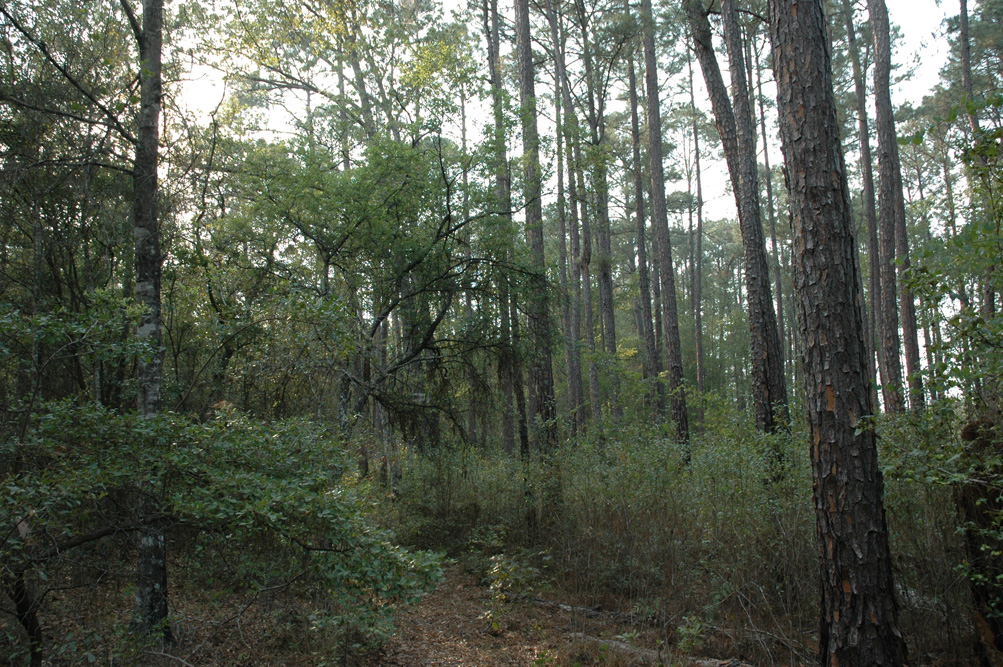
Longleaf pine forest near the parking area
We arrived at the Big Hammock Natural Area late afternoon on 16 May 2007. The parking area was in a slash pine forest. We followed a trail through the slash pine forest that led upward until we could see a large sand hill, which we had to veer off the trail to get to. The habitat there was dominated by oaks, especially turkey oak (Quercus laevis), sand live oak (Q. geminata), and myrtle oak (Q. myrtifolia), some of which were festooned with Spanish moss; palmettos (Serenoa repens); and woody goldenrod (Chrysoma pauciflosculosa). Also found in the area was a rare endemic shrub, Georgia plume (Elliottia racemosa). We restricted our ant collecting to this turkey oak scrub area (32°51'55"N82°02'59"W), as we were comparing the ant fauna of this sandhill habitat to that of Ohoopee Dunes N.A. in Emanual Co., GA (Ohoopee ants link) and Fall Line Sandhills N.A. in Taylor Co., GA (Fall Line Sandhills ants link).
One of the more interesting species of ants we collected at Big Hammock was Dorymyrmex bossutus (Trager), a relatively uncommon species apparently restricted to scrub and turkey oak sandhill habitats in Florida and Georgia. This attractive shiny species is bicolored with a dark brownish black head and gaster, pale brown appendages, and the rest of the body orangish. This represented the first collection of this species by us and for our Mississippi Entomological Museum (MEM). Somewhat surprisingly, this was this only Dorymyrmex species we collected at the site, although it was common there. Similar to many habitats with deep sand, we found numerous colonies of Forelius pruinosus (Roger) with alate females present. However, some of the workers appeared to have an extra couple of semi erect hairs on the propodeal dorsum, and the females were larger and shinier than typical F. pruinosus queens, although they were similarly bicolored. This may simply represent variation, or it could potentially mean that there is another species involved in an already much confused genus. For now, this will be referred to as F. pruinosus.
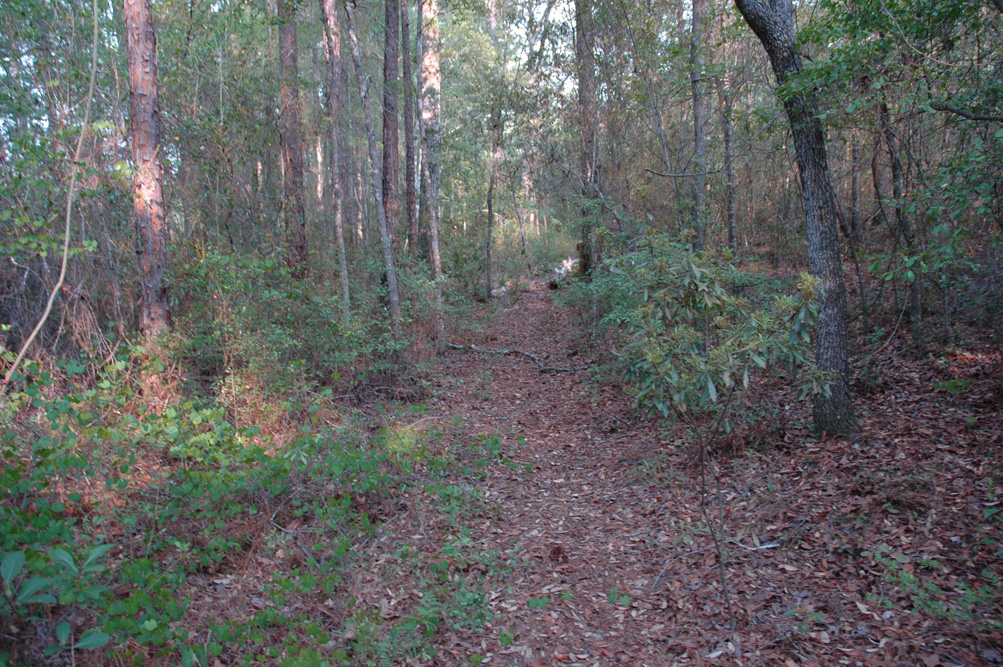
The trail leading through the natural area
Searching through the litter beneath palmettos, beside dead logs, and at bases of oaks revealed the presence of numerous colonies of Nylanderia parvula (Mayr). This is a small, dark species of Nylanderia that lacks erect hairs on the antennal scapes. Many small colonies of Nylanderia phantasma (Trager) were found in the open sand. This species is comparable in size to N. parvula, but is pale yellow and usually has 2-4 erect hairs on the scapes. It is similar in appearance to N. arenivaga, which is larger and has usually has more than 10 erect hairs on the scapes. Nylanderia phantasma is active nocturnally, and are easy to catch at night as they forage on the sandy floor. This species represents a new state record for Georgia.
Colonies of two species of carpenter ants, Camponotus castaneus (Latreille) and C. socius Roger, were discovered at the site. The C. castaneus colony was found in the rich and interwoven humus layer beneath oak litter in a slightly depressed area beneath a turkey oak. The colony was not overly large and less than twenty workers were observed. This species is distinctive with its reddish-orange coloration. The colony of C. socius was found in an open area and was marked by only an entrance hole. This colony was most likely an incipient one as only a single dealate queen and few workers were seen, and these were only a few cm deep. This species is mostly nocturnal, although workers will forage during daylight hours. Camponotus socius can be identified by its opaque reddish color, except on the gaster, which is dark brownish black with yellow banding.
Only one species of ponerine ant, Hypoponera opacior (Forel), was collected. Workers were found to be relatively common in leaf litter. This small brown ant is common and widespread throughout the southeastern U.S. We also found one common species of dacetine ant, Strumigenys ornata Mayr in the leaf litter. This widespread species is easily recognized by its unique whirl of elongate, bulbous tipped setae, which arise from the clypeus.
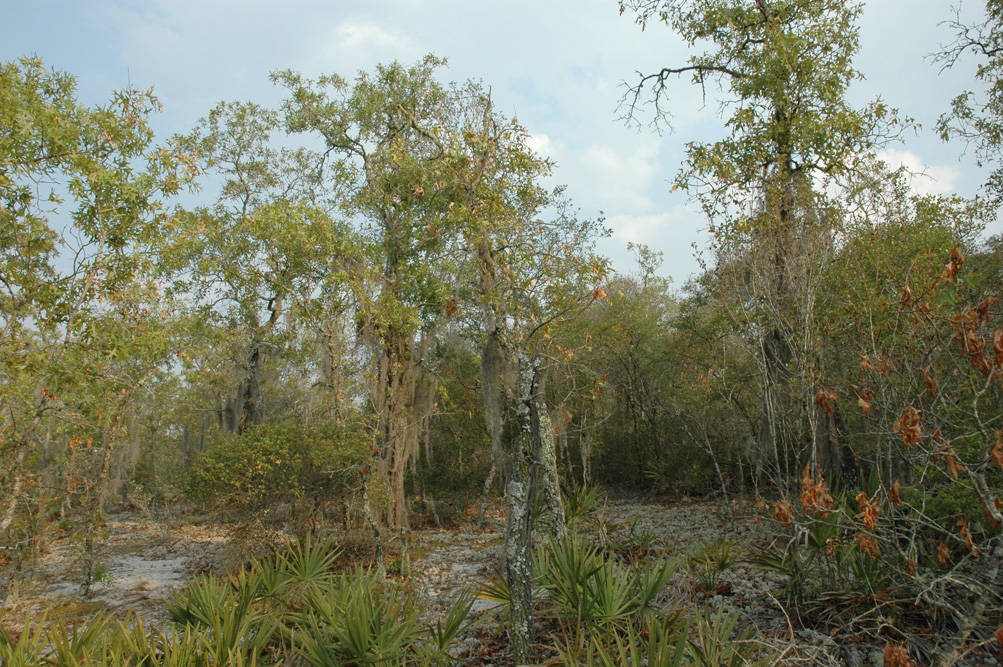
Sandhill habitat at Big Hammock Natural Area
Several colonies of Monomorium viridum Brown were found in the area. Each colony was marked by a ring of sand surrounding a central entrance hole. This species is apparently restricted to sandy habitats in the coastal plain. It is extremely difficult to separate workers of this species from M. minimum (Buckley) without queens, which are quite different in appearance. The queens of M. viridum are bicolored red with a blackish metallic green gaster, as compared with M. minimum, whose queens are black. Fortunately, we were able to find dealate queens in the colonies, and were confident in this identification. At least three other species in the same tribe, Solenopsidini (subfamily Myrmicinae), were found including S. invicta Buren, S. carolinensis Forel, and S. pergandei Forel. Solenopsis invicta is an exotic pest species that is widespread and often abundant in the Southeast, although it usually prefers disturbed habitats. However, it was not abundant at this site, and was only observed at the edge of the sandhill habitat. Members of the molesta or "thief ant" group are minute and very difficult to identify, especially without queens, which are more diagnostic than workers. No queens were collected at the site, but workers collected appeared to be S. carolinensis. Solenopsis pergandei was found nesting in the sand, which is typical for this species. This species, also in the thief ant group, is larger than most related species, is pale whitish-yellow, and has a circular postpetiole, and has large queens (compared to others in the group). This is one of the few species in the group that are relatively easy to identify.
Six species of Pheidolini were collected at the site including Aphaenogaster floridana Smith, A. treatae Forel, Pheidole adrianoi Naves, P. dentata Mayr, P. floridana Emery, and P. morrisi Forel. A colony of A. floridana was discovered in an open patch of sand. This species is easily identified by its yellowish-orange color, slender elongate body, and lack of propodeal spines. Colonies of A. treatae were found in the soil underneath leaf litter, and workers were seen foraging in the litter. This dark reddish-brown species is larger, has propodeal spines, and the basal fourth or more of the antennal scape is flattened. Workers of P. adrianoi and P. floridana were found as they foraged in the leaf litter during the day. Both of these species are apparently confined to sandy or sandhill habitats in the Southeast. Minor workers of P. adrianoi are brownish black in color, small for the genus, have strong and deep rugulae present on the mesopleurae and propodeal sides, and have thick, finger-like spines. Majors are reddish brown with strong and deep rugulae present on the side of the pronotum, mesopleurae and propodeal sides, and have thick, finger-like spines. Both minors and majors of P. floridana are concolorous yellow with foveolate punctation on the body (and head of minors). Pheidole dentata colonies were found in the sand beneath leaf litter and in rotting wood. This larger species is very common and widespread and is found in many wooded habitats. Workers are much larger than either P. adrianoi or P. floridana, are variable in color from reddish brown to brownish black, and possess propodeal spines. Workers of P. morrisi were also found foraging in the leaf litter, although no colonies were observed. This species is restricted to nesting in sandy soils. Both minors and majors are approximately the same size as in P. dentata, but both minors and majors are yellow in color and lack propodeal spines.
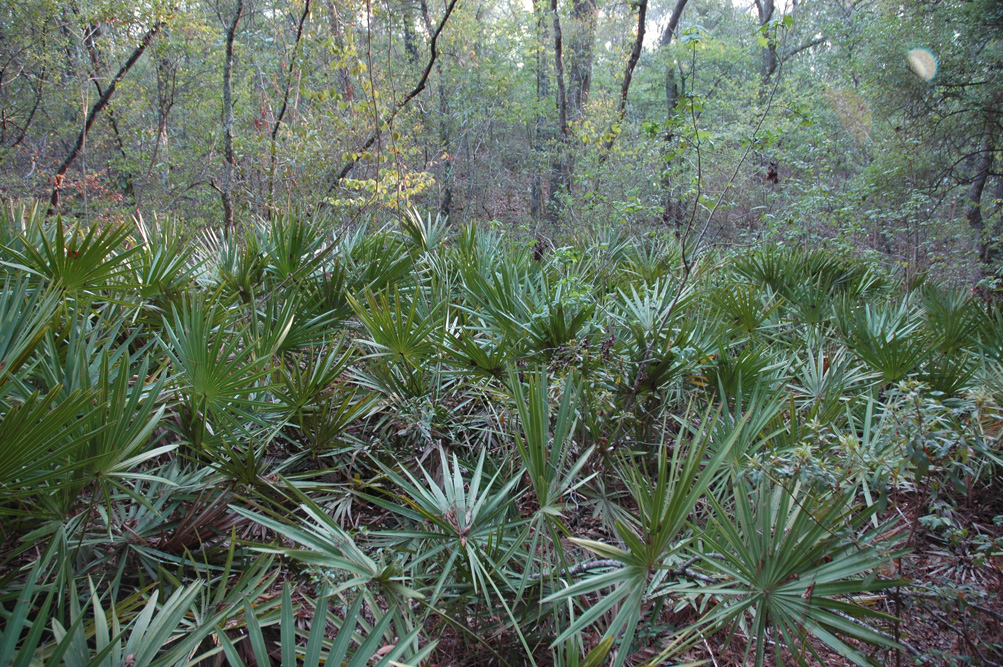
A group of palmettos in the sandhill habitat
Both Crematogaster ashmeadi Mayr and C. lineolata (Say) were collected at the site. Both of these species are found throughout the Southeast, were common at the site. Workers of C. ashmeadi were found crawling on vegetation, in leaf litter, and on tree trunks. This species is relatively small, dark brownish black, has short propodeal spines, and the sides of the pronotum are smooth and shining. Colonies of C. lineolata were found in rotting wood and workers were observed foraging throughout the area, especially in the litter. This species is also dark brown, has elongate propodeal spines, and the sides of the pronotum are roughened with transverse ridges.
Two species of Temnothorax, T. pergandei Emery and T. texanus Wheeler were collected as they crawled in leaf litter. Both of these species are somewhat atypical for eastern members of the genus in that they have 12 segmented antennae rather than 11 segmented antennae. T. pergandei is much bigger than other species in the genus and can be identified by its large size (much larger than other eastern species), 12 segmented antenna (T. palustris and T. texanus also have 12), mostly smooth integument, somewhat short propodeal spines, and deep mesonotal suture. The color of this species is variable from orangish-red to dark brownish-black. Workers of T. texanus are smaller, have much more sculpture on the body (especially on the head, alitrunk, and waist), relatively short propodeal spines that are directed posteriorly, and do not have an deep mesonotal suture. This dark reddish-brown species most closely resembles T. schaumii from which it differs by having a 12 segmented antennae and slightly longer spines. Myrmecina americana Emery, a very common and widespread species, was found in leaf litter. This black species (occasionally reddish) is easily distinguished by its characteristic sharp carina found along the ventrolateral margin of the head, sessile petiole, and bispinose propodeum.
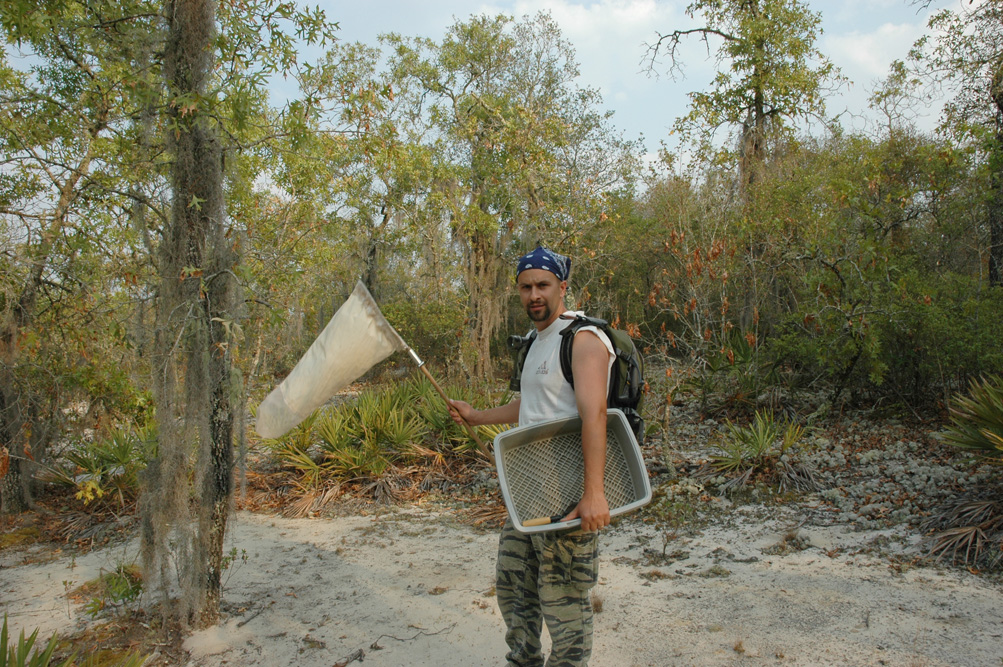
Jovonn, with collecting gear
A second visit was made to the Big Hammock site on 18 July 2007. We arrived at the site at approximately 5:00 P.M. and stayed there until approximately 11:00 P.M. John Barone, a researcher from Columbus State University in eastern Georgia, joined us for a few hours and studied plants and made numerous photographs of the area. Even though it was getting late in the day, it was still 95°F and very humid. However, the ant species that we found to be active during the day during our previous trip, were again active, despite the high temperature.
This journey was not overly productive in adding new species for the site, as we basically collected the same set of species as we did on the first visit including Dorymyrmex bossutus, Forelius pruinosus, Nylanderia parvula, N. phantasma, Camponotus castaneus, Hypoponera opacior, Trachymyrmex septentrionalis, Monomorium viridum, Aphaenogaster floridana, A. treatae, Pheidole adrianoi, P. dentata, P. floridana, P. morrisi, Crematogaster ashmeadi, and Temnothorax texanus. We only added one additional species for the site, Cyphomyrmex rimosus (Spinola). This small, dark brown exotic species is related to Trachymyrmex septentrionalis, but differs in size, color and in that projections arising from the body are apically rounded, whereas T. septentrionalis is larger, reddish-tan, and projections are irregular (not rounded). Only a dealate queen was found of the Cyphomyrmex, and it is possible that it may not be a typical inhabitant of the site.
The Trachymyrmex were as abundant as the first visit, and as soon as nightfall approached, workers emerged from their nest for house cleaning and foraging duties. It was interesting to observe the workers carrying individual grains of sand from within their nest to the top of their mound above the colony. While it was still light, we observed several dealate queens of this species crawling on the ground. Workers of two other species, N. phantasma and A. treatae, were also active after dark, especially the Nylanderia, which were seen in great numbers.
We made a our final journey to Big Hammock on 7 October, 2007, and arrived there at approximately 2:20 P.M. on a humid, hot day. Collecting was at times somewhat difficult, as we were caught in two rain showers that soaked us pretty well, and also made the sand and litter too wet to easily sift. We did not add any new species to the site, but we did once again note the presence of the same common species nesting in the sandy area. Once again, nests of D. bossutus, F. pruinosus, N. phantasma, T. septentrionalis, M. viridum, A. floridana, A. treatae, and C. lineolata were found to be common. Unfortunately, we also found a few more colonies of S. invicta, although they were not common. Workers of N. parvula, H. opacior, and T. pergandei were found in the litter, but nests were not located. We continued our collections into the night, with the addition of some blacklights at sheets. No additional species were found during our night collections, but once again, the activity levels of N. phantasma and T. septentrionalis were observed to be very high. In general, the community of ants apparently typical for this particular site were just as abundant as they were in May and July.
Overall, 25 species of ants were collected at the sandhill habitat at Big Hammock N. A. Although some of the species collected are widespread and found in a variety of habitats, ten species that we collected are typically restricted to sandy habitats. These species were Dorymyrmex bossutus, Forelius pruinosus, Nylanderia phantasma, Camponotus socius, Monomorium viridum, Solenopsis pergandei, Aphaenogaster floridana, Pheidole adrianoi, P. floridana, and P. morrisi. The collection of D. bossutus and N. phantasma, which are not usually found in disturbed sites, indicated that this locality was relatively undisturbed. Only two exotic species, C. rimosus and S. invicta, were collected, with only a single queen of the Cyphomyrmex being found and only few colonies of Solenopsis being discovered. The 25 species collected at this site were slightly less than we found in sandhill habitat at the Fall Line Sandhill N.A. in Taylor County where we collected 33 species, and much less than the 76 species that we collected from Ohoopee Dunes in Emanual County. This was not surprising, as the Ohoopee Dunes area is much more extensive and we made more collections there. However, the species composition from Big Hammock was much more interesting than that of the Fall Line Sandhills, which was dominated by species that thrive in disturbed sand habitats. Big Hammock had some affinities with the Ohoopee fauna, but there were some obvious differences. This was the only site where we collected D. bossutus, a species which is restricted to sandhill or scrub habitats, and interestingly, it was the only Dorymyrmex species seen there. Although workers of M. viridum were collected at Ohoopee, no colonies were noted, and they appeared to be much more abundant at Big Hammock. No colonies of Pogonomyrmex were found at Big Hammock, and perhaps there was not enough open areas for them, or possibly the extreme slope of the site was too much for their colonies. Big Hammock and Ohoopee shared 12 species of ants that were not found at the Fall Line Sandhills sites including N. parvula, N. phantasma, C. castaneus, C. socius, M. viridum, A. treatae, P. floridana, P. morrisi, C. ashmeadi, C. lineolata, T. pergandei, and T. texanus. All three sites (Big Hammock, Ohoopee, and Fall Line Sandhills) shared the following 12 species: F. pruinosus, H. opacior, S. ornata, C. rimosus, T. septentrionalis, S. carolinensis, S. invicta, S. pergandei, A. floridana, P. adrianoi, P. dentata, and M. americana. No species were shared with Fall Line Sandhills that were not also found at Ohoopee. To compare the species of ants from Big Hammock to other localities with similar habitats, click on the links below under the heading "links to ants of other sandhill or sand dune habitats".
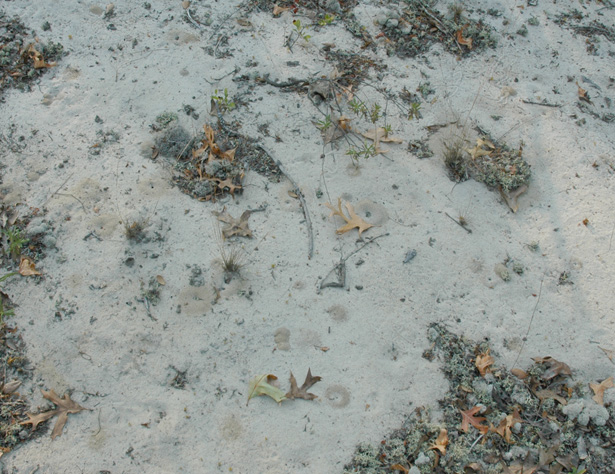
A view of the ground showing the craters of various ant species
Formicidae List (arranged alphabetically by genus)
Aphaenogaster floridana Smith
Aphaenogaster treatae Forel
Camponotus castaneus (Latreille)
Camponotus socius Roger
Crematogaster ashmeadi Mayr
Crematogaster lineolata (Say)
Cyphomyrmex rimosus (Spinola) Exotic
Dorymyrmex bossutus (Trager)
Forelius pruinosus (Roger)
Hypoponera opacior (Forel)
Monomorium viridum Brown
Myrmecina americana Emery
Nylanderia parvula (Mayr)
Nylanderia phantasma (Trager) (new record for GA)
Pheidole adrianoi Naves
Pheidole dentata Mayr
Pheidole bilimeki Mayr
Pheidole morrisi Forel
Solenopsis invicta Buren Exotic (only found at edge of dune area)
Solenopsis carolinensis Forel
Solenopsis pergandei Forel
Strumigenys ornata Mayr
Temnothorax pergandei Emery
Temnothorax texanus Wheeler
Trachymyrmex septentrionalis (McCook)
Links to ants of other sandhill or sand dune habitats
Ants of Deaton Preserve, Greene County, Mississippi
Ants of Horn Island, Jackson County, Mississippi
Ants of Palestinian Gardens, George County, Mississippi
Ants of Bon Secour National Wildlife Refuge, Baldwin County, Alabama
Ants of Fall Line Sandhills Natural Area, Taylor County, Georgia
Ants of Ohoopee Dunes Natural Area, Emanuel County, Georgia
Site info
GA, Tattnall Co.
Big Hammock Natural Area
32°51'55"N82°02'59"W
pine-oak dune woodland
Acknowledgments
This research was conducted with support from the Mississippi Entomological Museum, the Georgia Department of Natural Resources, and the USDA-ARS Areawide Management of Imported Fire Ant Project (Richard L. Brown, Principal Investigator).
Graham, J. H., H. H. Hughie, S. Jones, K. Wrinn, A. J. Krzysik, J. J. Duda, D. C. Freeman, J. M. Emlen, J. C. Zak, D. A. Kovacic, C. Chamberlin-Graham, and H. Balbach. 2004. Habitat disturbance and the diversity and abundance of ants (Formicidae) in the southeastern fall-line sandhills. Journal of Insect Science 4: 30, 15 pp.
Ipser, R. M., M. A. Brinkman, W. A. Gardner, and H. B. Peeler. 2004. A survey of the ground-dwelling ants (Hymenoptera: Formicidae) in Georgia. Florida Entomologist 87: 253-260.
Lubertazzi, D. and W. Tschinkel. 2003. Ant community change across a ground vegetation gradient in north Florida's longleaf pine flatwoods. Journal of Insect Science 3: (21) 17 pp.
Van Pelt, A. F. Jr. 1956. The ecology of the ants of the Wellaka reserve, Florida (Hymenoptera: Formicidae). The American Midland Naturalist 59: 1-57.


